Falcated Duck (Anas falcata) Male photos by Larry Jordan
A vagrant Falcated Duck (Anas falcata), a bird you would normally see in Asia, was first spotted at Colusa National Wildlife Refuge on December 8th (click on photos for full sized images). Colusa National Wildlife Refuge is part of the Sacramento National Wildlife Refuge Complex located about 90 miles North of Sacramento, California’s state capitol.
Colusa National Wildlife Refuge is part of this complex of five national wildlife refuges (NWR) and three wildlife management areas (WMA) found in California’s central valley. It is located about 6 miles east of Interstate 5 on Highway 20. A map of the refuge can be found here showing the location of the viewing platform, auto loop, restrooms and photography blind.
Colusa National Wildlife Refuge occupies 4,567 acres, including seasonal marsh, permanent ponds, and uplands1. It includes a three mile auto loop, a one mile walking trail and a photography blind that you can reserve like I did this weekend 😉
I didn’t see this Near Threatened (NT) species from the photo blind though, it has been visible to everyone from the observation deck at the refuge entrance!
Birdlife International and the IUCN Redlist categorize the Falcated Duck as Near Threatened mainly because of its rapid decline in China due to over hunting2. You can read more about the status of this duck by clicking the link above.
This Falcated Duck drake has been seen in the constant company of a pair of American Wigeon near the observation platform almost daily since it was discovered. Notice I said almost daily. I missed seeing the bird in my first attempt a few weeks ago but I figured I had another shot at him this weekend since I had the blind reserved anyway.
It was lucky Friday the 13th for me when he showed up at about 2 o’clock in the afternoon and moved to within about fifty yards of the platform to the thrill of the birders in wait. He spent most of his time foraging with the American Wigeon pair but I caught this video of him as he bathed and preened.
As you can see, this drake is beautiful with his iridescent green and bronze head and the elongated, arched tertial feathers after which it is named.
Here is a sweet shot of him preening. A good time was had by all!
This post is linked to Bird Photography Weekly and will be linked to World Bird Wednesday on Tuesday morning. Please go check out both of these wonderful bird photography memes.
References: 1Sacramento National Wildlife Refuge, 2BirdLife International

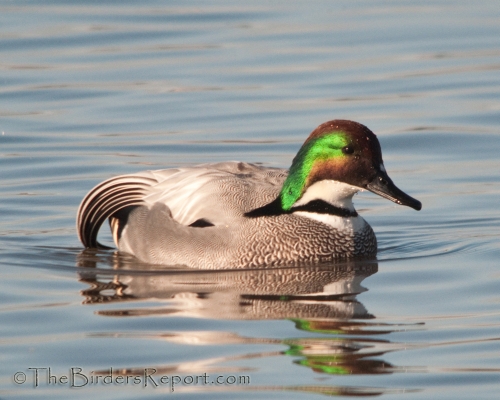
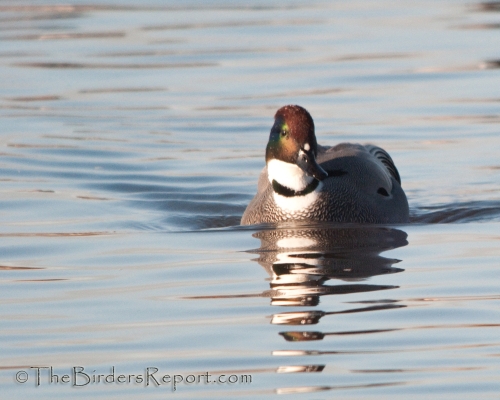
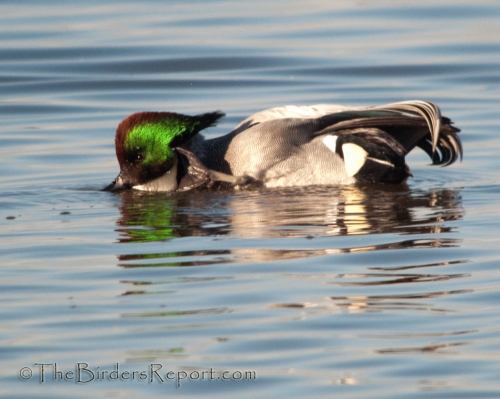
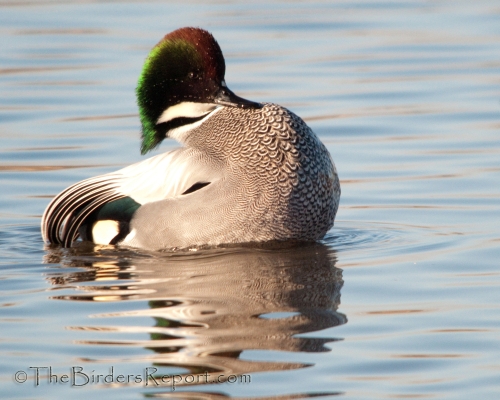
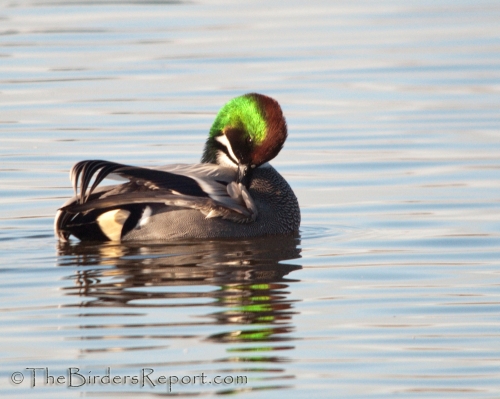








Comments on this entry are closed.
I have only seen this in a photo once before. It is such a nice bird. Thanks for sharing and for the video.
Larry, this must have been a wonderful experience to see this vagrant visitor from Asia, I would be on Cloud 9. The bird is gorgeous and your images show that well. Wow…
@NF before this bird found its way to California I had never heard of a Falcated Duck!
@Mia indeed it was nice to just see this bird but as it moved closer and closer to the viewing platform I moved closer and closer to cloud 9 myself!
a friend of mine posted about this type of duck on his blog a week or so ago. i’m going to send him over here to see if he’s in your area (he’s CA also).
@Theresa thanks! If he’s near he would probably want to go see this duck
He is beautiful Larry. I can’t imagine how exciting this sighting must have been. I wonder how long he’ll stay there, where he’ll go when he leaves ….or if more will come, maybe he is the scout ;>)
I was also interested to read that you can (must?) reserve the blinds in this refuge.
@Sallie as far as I know, they think this is a wild duck as opposed to an escapee from someone’s exotic duck collection. Who knows how long it will stay? Most wintering ducks begin leaving the area by March but maybe he is a scout 😉
The photo blinds at the Sacramento National Wildlife Refuge Complex must be reserved and the lottery requests are received during the month of August each year.
I read about this fellow before, amazing!. Glad you caught such beautiful photos of him!
Amazing how far they can stray!! Boom & Gary of the Vermilon River, Canada.
He is indeed beautiful!
Beautiful duck!
Great images and video, Larry. I don’t know if we will get back before migration, especially if we are at last headed into the rainy season.
A wonderful post Larry
Interesting post and pics of this rarity Larry. Just goes to show that you never know what the winds may bring in.
Great photos and a very interesting duck to find so far from its usual haunts.
It is a beautiful duck, congrats on the sighting. Wonderful photos.
I am so happy you had the opportunity to observe this beautiful bird upclose. Thank you for sharing your photos and video!
Gorgeous images of a beautiful duck, Larry. It’s always thrilling to see a rarity like this. I am a bit envious.
Such a beautiful bird!
This is the best Chinese import of all time!
Cheers to you Sir!
Thank you for linking up to Nature Notes Larry, I appreciate it and all you do for wildlife.. This guy is so cute…I don’t understand all the hunting. Even here there are plenty of mallards, but wood duck populations are down and they are second only to mallards in being hunted..but then I am not a hunter…love the preening….Michelle
Thank you everyone for your wonderful comments. It was a real treat to see this duck and be able to observe his behavior for over an hour along with several other bird enthusiasts on the platform at Colusa NWR.
I was just there yesterday and the Falcated Duck is still visible from the viewing platform. We also counted over 60+ Night Herons in a shrub near the bridge. 3 White Faced Ibis were also present. Numerous Coots, Pintails, Cinnamon’s, Snow Geese, Ross’s Geese and Shovelers too. The Greater Egrets are beautiful in their winter breeding plumage. A great birding time!